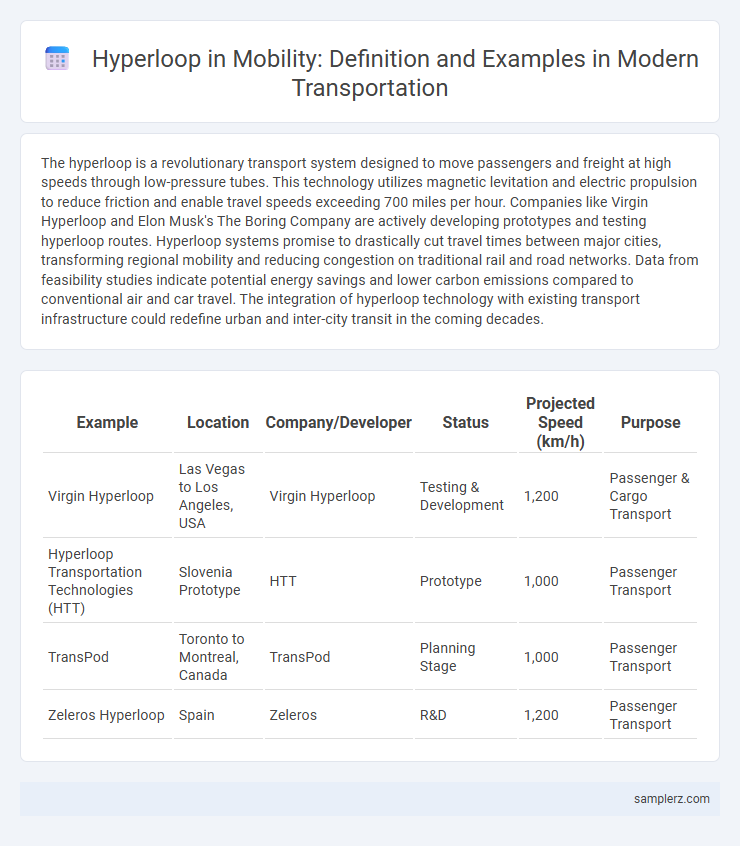The hyperloop is a revolutionary transport system designed to move passengers and freight at high speeds through low-pressure tubes. This technology utilizes magnetic levitation and electric propulsion to reduce friction and enable travel speeds exceeding 700 miles per hour. Companies like Virgin Hyperloop and Elon Musk's The Boring Company are actively developing prototypes and testing hyperloop routes. Hyperloop systems promise to drastically cut travel times between major cities, transforming regional mobility and reducing congestion on traditional rail and road networks. Data from feasibility studies indicate potential energy savings and lower carbon emissions compared to conventional air and car travel. The integration of hyperloop technology with existing transport infrastructure could redefine urban and inter-city transit in the coming decades.
Table of Comparison
| Example | Location | Company/Developer | Status | Projected Speed (km/h) | Purpose |
|---|---|---|---|---|---|
| Virgin Hyperloop | Las Vegas to Los Angeles, USA | Virgin Hyperloop | Testing & Development | 1,200 | Passenger & Cargo Transport |
| Hyperloop Transportation Technologies (HTT) | Slovenia Prototype | HTT | Prototype | 1,000 | Passenger Transport |
| TransPod | Toronto to Montreal, Canada | TransPod | Planning Stage | 1,000 | Passenger Transport |
| Zeleros Hyperloop | Spain | Zeleros | R&D | 1,200 | Passenger Transport |
Introduction to Hyperloop Technology in Mobility
Hyperloop technology revolutionizes mobility by enabling ultra-fast transportation through low-pressure tubes, significantly reducing travel time between cities. Utilizing magnetic levitation and electric propulsion, hyperloop pods achieve speeds exceeding 700 miles per hour while maintaining energy efficiency and minimal emissions. This innovative system promises to transform urban connectivity, enhance passenger experience, and support sustainable transportation infrastructure worldwide.
Historical Milestones of Hyperloop Development
The Hyperloop concept originated in 2013 with Elon Musk's white paper proposing near-supersonic travel in low-pressure tubes. Virgin Hyperloop successfully completed its first human test in 2020, marking a major milestone towards commercial viability. Ongoing advancements in magnetic levitation, vacuum tube technology, and regulatory frameworks continue to shape the future of Hyperloop transport systems.
Key Hyperloop Projects Around the World
Key hyperloop projects around the world include Virgin Hyperloop in the United States, which has successfully tested passenger pods and aims to revolutionize regional travel with speeds exceeding 600 mph. Europe's Hardt Hyperloop focuses on sustainable and efficient transport, developing infrastructure to connect major cities like Amsterdam and Frankfurt. In the Middle East, the Dubai Hyperloop initiative plans to create ultra-fast transit corridors linking Dubai and Abu Dhabi, dramatically reducing travel times within the region.
Hyperloop vs Traditional Public Transport
Hyperloop technology offers speeds of up to 700 mph, drastically reducing travel times compared to traditional public transport systems like buses and trains, which average 30-60 mph. Its magnetic levitation and low-pressure tubes minimize friction, enhancing energy efficiency and sustainability beyond diesel or electric-powered transit. Infrastructure costs vary, yet Hyperloop promises scalable routes with fewer stops, reshaping urban mobility and long-distance travel dynamics.
Hyperloop Implementation in Urban Areas
Hyperloop implementation in urban areas promises to revolutionize public transportation by enabling ultra-fast, energy-efficient travel between city centers and suburbs. Key projects like Virgin Hyperloop and Hardt Hyperloop focus on integrating vacuum tube technology with existing infrastructure to reduce congestion and travel times drastically. Urban planners emphasize seamless connectivity and sustainable designs to enhance commuter experience and support smart city development.
Case Study: Virgin Hyperloop One’s Commercial Routes
Virgin Hyperloop One's commercial routes demonstrate the potential of high-speed, sustainable urban mobility by significantly reducing travel times between key metropolitan areas. The case study highlights the hyperloop's capacity to transport passengers at speeds exceeding 600 miles per hour, enabling rapid connections across regions while minimizing carbon emissions compared to conventional transport. This innovative system exemplifies the future of mass transit, combining aerodynamic efficiency with magnetic levitation technology to revolutionize intercity travel.
Environmental Impact of Hyperloop Transport
Hyperloop transport significantly reduces carbon emissions by using electric propulsion systems powered by renewable energy sources, minimizing reliance on fossil fuels. Its vacuum-sealed tubes decrease air resistance, allowing high-speed travel with substantially lower energy consumption compared to traditional rail or air transport. This innovation can drastically lower the environmental footprint of long-distance travel, contributing to cleaner, more sustainable mobility solutions.
Hyperloop in Freight and Logistics Mobility
Hyperloop technology offers groundbreaking advancements in freight and logistics mobility by enabling ultra-fast, energy-efficient transportation of goods through near-vacuum tubes, significantly reducing transit times compared to traditional rail or road systems. Companies like Virgin Hyperloop are actively developing cargo-specific pods that can transport large volumes of freight with minimal carbon footprint, enhancing supply chain reliability and reducing logistical costs. This innovation has the potential to revolutionize intercity and regional freight transport by increasing speed, lowering emissions, and improving overall freight network efficiency.
Challenges Facing Hyperloop Adoption
Hyperloop technology faces significant challenges including high infrastructure costs, regulatory hurdles, and safety concerns related to high-speed travel in near-vacuum tubes. Integrating Hyperloop systems with existing transportation networks requires overcoming complex engineering and urban planning barriers. Public acceptance remains uncertain due to perceived risks and limited real-world testing of Hyperloop prototypes.
Future Prospects for Hyperloop in Global Mobility
Hyperloop technology promises to revolutionize global mobility by enabling ultra-high-speed travel exceeding 700 mph, drastically reducing commute times and connecting major urban centers. Investments from leading companies, such as Virgin Hyperloop and Elon Musk's ventures, drive innovations in magnetic levitation and low-pressure tube systems, targeting commercial deployment within the next decade. Governments worldwide are evaluating regulatory frameworks and infrastructure integration to harness hyperloop's potential for sustainable, efficient, and scalable transportation networks.

example of hyperloop in transport Infographic
 samplerz.com
samplerz.com